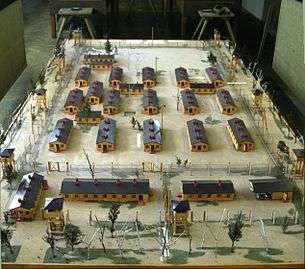Stalag

In Germany, stalag (German pronunciation: [ˈʃtalak]) was a term used for prisoner-of-war camps. Stalag is a contraction of "Stammlager", itself short for Kriegsgefangenen-Mannschafts-Stammlager.[1]
Legal definitions
According to the Third Geneva Convention of 1929 and its predecessor, the Hague Convention of 1907, Section IV, Chapter 2,[2] those camps were only for prisoners of war, not civilians. Stalags were operated in both World War I and World War II and intended to be used for non-commissioned personnel (Enlisted ranks in US Army, Other ranks in British Commonwealth forces). Officers were held in separate camps called Oflag. During World War II, the Luftwaffe (German air force) operated Stalag Luft in which flying personnel, both officers and non-commissioned officers were held. The Kriegsmarine (German navy) operated Marlag for Navy personnel and Milag for Merchant Navy personnel.
Civilians who were officially attached to military units, such as war correspondents, were provided the same treatment as military personnel by the Conventions.
The Third Geneva Convention, Section III, Article 49, permits non-commissioned personnel of lower ranks to be used for work in agriculture and industry, but not in any industry producing war material. Further articles of Section III detailed conditions under which they should work, be housed and paid. During World War II these latter provisions were consistently breached, in particular for Russian, Polish, and Yugoslav prisoners. According to the Nazi ideology, Slavic people were regarded as rassisch minderwertig ("racially inferior").
Prisoners of various nationalities were generally separated from each other by barbed-wire fences subdividing each stalag into sections. Frequently prisoners speaking the same language, for example British Commonwealth soldiers, were permitted to intermingle.
Arbeitskommandos
At each stalag the German Army set up sub-camps called Arbeitskommando to hold prisoners in the vicinity of specific work locations, whether factories, coal-mines, quarries, farms or railroad maintenance. These sub-camps sometimes held more than 1,000 prisoners, separated by nationality.[3] The sub-camps were administered by the parent stalag, which maintained personnel records, collected mail, International Red Cross packages and then delivered to the individual Arbeitskommando. Likewise any individuals that were injured in work, or became ill, were returned to the Lazarett (medical care facilities) at the parent stalag.
Best-known stalags
Stalag Luft III, a large prisoner of war camp near Sagan, Silesia, Germany (now Żagań, Poland), was the site of a spectacular escape attempt (later filmed as The Great Escape). On March 24, 1944, 76 Allied prisoners escaped through a 110 m (approx 360 feet) long tunnel. 73 were recaptured within two weeks. 50 of them were executed by order of Hitler in the Stalag Luft III murders.
The largest German World War II prisoner of war camp was Stalag VII-A at Moosburg, Germany. Over 130,000 Allied soldiers were imprisoned there. It was liberated by the U.S. 14th Armored Division following a short battle with SS soldiers of the 17th SS Panzer Grenadier Division on 29 April 1945.[1] Stalag III-C is notable for the escape of US paratrooper Joseph Beyrle, who subsequently joined a Soviet tank battalion commanded by Aleksandra Samusenko, which returned to liberate the camp.
In popular culture
The airmen in the show Hogan's Heroes were imprisoned in fictitious "Luft Stalag 13" near Hammelburg.
The World War II play Stalag 17, which was made into the 1953 movie Stalag 17, was set in Stalag XVII-B, located near Krems, Austria.
The movie Hart's War was set in Stalag VI-A, near Hemer/Iserlohn in Military District VI
In Israel of the 1950s-60s, "stalag" was a generic term for pornographic material with a theme of sadistic sexual activity between female SS officers and prisoners of war. In 2007, Ari Libsker made a film on this topic, entitled Stalags.
See also
References
- 1 2 "POW camp Stalag VII A: Brief history". at Moosburg Online
- ↑
- ↑ Stalag VII A: Kommandos at Moosburg Online, updated 27 June 2011
External links
- (in French) La GUEFANGUE - La Vie des prisonniers de guerre Français en Basse-Bavière - 1939-1945 par Roger DEVAUX
- German prisoner of war camps
- Lamsdorf Reunited
- Arbeitskommando 10001 in Ruckenwaldau (now Wierzbowa, Lower Silesia - Poland), Agency Camp German Stalag VIII-A.
- List of POW camps in Germany and occupied territories
- pl:Stalag Luft II